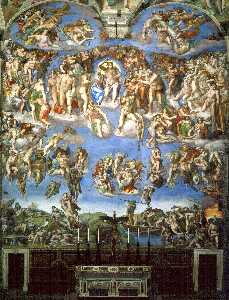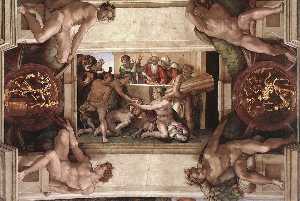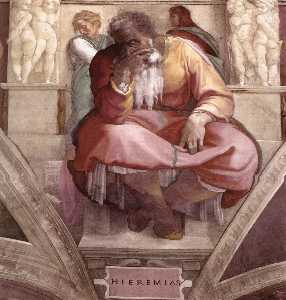Artist: Michelangelo Buonarroti
Style: High Renaissance
Topic: Characters Virgin Mary
Technique: Sculpture
The Rondanini Pietà is a marble sculpture that Michelangelo worked on from the 1550s until the last days of his life, in 1564. It is housed in the Castello Sforzesco in Milan. His final sculpture, the Rondanini Pietà revisited the theme of the Virgin Mary mourning over the body of the dead Christ, which he had first explored in his Pietà of 1499. Like his late series of drawings of the Crucifixion and the sculpture of the Deposition of Christ intended for his own tomb, it was produced at a time when Michelangelo's sense of his own mortality (and with it his spirituality) was growing. The Rondanini Pietà was begun before the Deposition, although in his dying days Michelangelo hacked at the marble block until only the dismembered right arm of Christ survived from the sculpture as originally conceived. The spectral, waif-like Virgin and Christ are a departure from the idealised figures that exemplified the sculptor's earlier style, and have been said to bear more of a resemblance to the attenuated figures of Gothic sculpture than those of the Renaissance.
Artist |
|
|---|---|
Download |
|
Permissions |
Free for non commercial use. See below. |
Michelangelo Buonarroti – Most viewed artworks
|
This image (or other media file) is in the public domain because its copyright has expired. However - you may not use this image for commercial purposes and you may not alter the image or remove the watermark. This applies to the United States, Canada, the European Union and those countries with a copyright term of life of the author plus 70 years.
|















 Note that a few countries have copyright terms longer than 70 years: Mexico has 100 years, Colombia has 80 years, and Guatemala and Samoa have 75 years. This image may
not be in the public domain in these countries, which moreover do not implement the
Note that a few countries have copyright terms longer than 70 years: Mexico has 100 years, Colombia has 80 years, and Guatemala and Samoa have 75 years. This image may
not be in the public domain in these countries, which moreover do not implement the